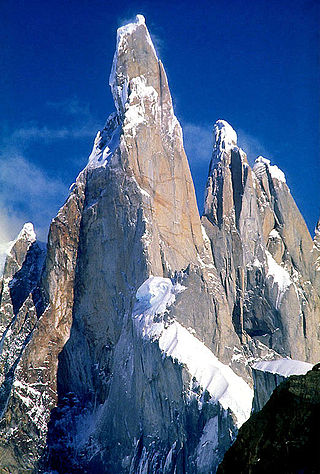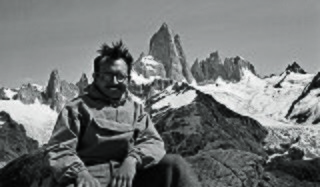
Santa Cruz Province is a province of Argentina, located in the southern part of the country, in Patagonia. It borders Chubut Province to the north, and Chile to the west and south, with the Atlantic coast to the east. Santa Cruz is the second-largest province of the country, and the least densely populated in mainland Argentina.

Los Glaciares National Park is a federal protected area in Santa Cruz Province, Argentina.

The Perito Moreno, Francisco Gormaz or Bismarck Glacier is a glacier located in Los Glaciares National Park in southwest Santa Cruz Province, Argentina, and originated in the Magallanes Region in Chile, being also part of the Bernardo O'Higgins National Park. It is one of the most important tourist attractions in the Argentine Patagonia.

Cerro Torre is one of the mountains of the Southern Patagonian Ice Field in South America. It is located on the border dividing Argentina and Chile, west of Fitz Roy. At 3,128 m (10,262 ft), the peak is the highest of a four mountain chain: the other peaks are Torre Egger, Punta Herron, and Cerro Standhardt. The top of the mountain often has a mushroom of rime ice, formed by the constant strong winds, increasing the difficulty of reaching the actual summit.

Monte Fitz Roy is a mountain in Patagonia, on the border between Argentina and Chile. It is located in the Southern Patagonian Ice Field, near El Chaltén village and Viedma Lake. It was first climbed in 1952 by French alpinists Lionel Terray and Guido Magnone.

The Southern Patagonian Ice Field, located at the Southern Patagonic Andes between Chile and Argentina, is the world's second largest contiguous extrapolar ice field. It is the bigger of two remnant parts of the Patagonian Ice Sheet, which covered all of southern Chile during the last glacial period, locally called the Llanquihue glaciation.

International relations between the Republic of Chile and the Argentine Republic have existed for decades. The border between the two countries is the world's third-longest international border, which is 5,300 km (3,300 mi) long and runs from north to south along the Andes mountains. Although both countries gained their independence during the South American wars of liberation, during much of the 19th and the 20th century, relations between the countries were tense as a result of disputes over the border in Patagonia. Despite this, Chile and Argentina have never been engaged in a war with each other. In recent years, relations have improved. Argentina and Chile have followed quite different economic policies. Chile has signed free trade agreements with countries such as China, the United States, Canada, South Korea, as well as European Union, and it's a member of the APEC. Argentina belongs to the Mercosur regional free trade area. In April 2018, both countries suspended their membership from the UNASUR.

Louis Lliboutry was a French glaciologist, geophysicist, and mountaineer. While in Chile in the early 1950s, he analysed and explained the formation of snow penitents in the Andes, which marked his first contribution to glaciology. He founded in Grenoble in 1958 the Laboratory of Alpine Glaciology and headed it for 25 years; he also set up at that period a pioneering syllabus in geophysics. His contributions to mechanics of viscous media and to geodynamics are internationally acknowledged.

Marcos José Couch, Argentine mountain climber, known for his professional achievements in mountains such as the Shishapangma in Tibet, or the Fitz Roy in Patagonia. Since 1987 he is a mountain guide and has been working internationally.

The Circo de los Altares is a geological formation of the Patagonian Andes, located in the Southern Patagonian Ice Field, where Mount Torre and Mount Fitz Roy can be seen from its western sides. It is located within the Area in dispute between Chile and Argentina with the border being defined in the northern area of the site.

The Southern Patagonian ice field dispute is a border dispute between Argentina and Chile over the delineation of the boundary line between the two countries on the Southern Patagonian Ice Field, a large expanse of glaciers located in the Patagonian Andes, which is the largest non-polar continental ice field with land access. It is called continental ice in Argentina and southern ice field in Chile, to differentiate it from the northern ice field. 2024, the Argentine–Chilean border in this sector is still pending of definition according to the 1998 agreement signed by both countries. The original border was defined 100 years prior on 1 October 1898 by experts from both countries.

The Chaltén Mountain Range Natural Site is a natural site part of the Bernardo O'Higgins National Park in the Magallanes and Chilean Antarctica Region, Chile. It is located between the boundary demarcated by the 1994 arbitration award and section B of the 1998 agreement between Argentina and Chile. It has an area of 768 hectares.
The Cerro Roma, Cerro Vivod, Cerro Bertrand, or Agassiz Norte is a mountain in the Andes, located on the border between Argentina and Chile, in the Patagonia region. The mountain reaches 3,180 m a.s.l. and is located near the westernmost point of Argentina, as defined by the 1998 agreement.

Huemul Pass is a mountain pass located in the disputed area between Chile and Argentina in the Southern Patagonian Ice Field. The pass connects the Viedma Glacier with the Argentine town of El Chaltén.

The Cerro Huemul is a glaciated mountain in the Andes located on the eastern edge of the Southern Patagonian Ice Field, west of Lake Viedma and north of the Viedma Glacier within the disputed area between Chile and Argentina.
Cerro Heim is a mountain in the Southern Patagonian Ice Field. It is located in Santa Cruz Province, Argentina, and is part of Los Glaciares National Park. Prior to the 1998 agreement between Argentina and Chile, this hill was considered a border landmark by Chile and was established as a landmark by the surveyors of both countries in the 1898 protocol. It stands at an altitude of 2,465 m (8,087 ft).
The Cerro Cervantes is a mountain in the Southern Patagonian Ice Field with an elevation of 2,380 meters above sea level or 680 meters above the surrounding terrain. Its foothills are about 5.6 kilometers wide. It is located in Santa Cruz Province, Argentina, and is part of Los Glaciares National Park. Before the 1998 agreement between Argentina and Chile, this mountain was considered a border landmark by Chile.

Cerro Mayo or de Mayo is a mountain located in the Southern Patagonian Ice Field, in Santa Cruz Province, Argentina. It is part of Los Glaciares National Park.
Cerro Campana is a glaciated mountain in the Andes mountain range in Patagonia, located on the eastern edge of the Southern Patagonian Ice Field, west of Lake Viedma, and south of the glacier of the same name within the disputed area between Chile and Argentina.

The Del Viento Pass is a mountain pass located in the disputed area between Chile and Argentina in the Southern Patagonian Ice Field. The pass connects the ice field with the Argentine town of El Chaltén.














